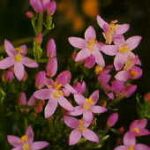| Common Name: |
Centaury |
| Other Names: |
Feverwort |
| Botanical Name: |
Centaurium erythrae syn. Erythraea centaurium |
| Genus: |
Centaurium |
| Family: |
Gentianaceae |
| Location: |
Dry grassland and dunes in Europe and SW Asia. Naturalized in N America |
| Cultivation: |
Sandy, neutral to alkaline soil in sun. |
| Propagation: |
By seed sown when ripe. |
| Harvest: |
Flowering plants are cut in summer and dried for infusions and liquid extracts. |
| Height: |
15-24cm (6-10in) |
| :Width |
7-15cm (3-6in) |
| Hardiness: |
Z4-8 |
| Parts Used: |
Whole plant |
| Properties: |
A very bitter, dry herb that acts as a tonic for the digestive system and lowers fevers. |
| Medicinal Uses: |
Internally for dyspepsia, liver and gall bladder complaints, hepatitis, jaundice, anorexia, post-viral syndrome, poor appetite in convalescence, and feverish illnesses. Combined with Althea officinalis (See, marshmallow), Chamaemelum nobile (See, chamomile), and Filipendula ulmaria (See, meadowsweet), for dyspepsia, and with Berberis vulgaris (See, barberry) and Rumex crispus (See, curled dock) for jaundice. Not given to pregnant women. |
| Bibliography: |
Encylopedia of Herbs by Deni Brown Copyright ©: 1995, 2001 Dorling Kindersley Limited pg 162
|

